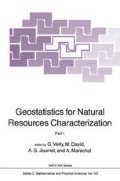Abstract
Disjunctive kriging is a general method, but the usual technique based upon Gaussian anamorphoses and Hermitian expansions become irrelevant in the case of discrete laws or, more generally, if the distribution possesses an atomic part. Isofactorial models with discrete laws, which are relevant in these cases, are suggested.
Access this chapter
Tax calculation will be finalised at checkout
Purchases are for personal use only
Preview
Unable to display preview. Download preview PDF.
References
Isofactorial models originate from Quantum Mechanics, where they have been widely and systematically used since the twenties. See for instance [+]. In particular, Hermite polynomials appear as eigen functions in the case of the one dimensional harmonic oscillator. Among statisticians, this Hermitian model and some others are mentioned by Cramer [5] as early as 1945. Isofactorial models were also used in the field of Markov processes, see [6]. In data analysis, thev constituted the starting point of correspondence analysis, [7], [8]. In Geostatistics, they have been used since 1973, [9], [l]. Note well that in general the factors are not polynomials. But, at the request of the reviewer, I also mention the fact that reference [l0] discusses orthogonal polynomials.
Matheron, G., “A Simple Substitute for Conditional Expectation the Disjunctive Kriging”, Proc. NATO ASI, “Advanced Geostatistics in the Mining Industry”, D. Reidel, p. 221–236. 1976.
Matheron, G., “Modèles Isofactoriels et Changement de Support” CGMM, Fontainebleau, 1983.
Matheron, G., “Remarques sur les Changements de Support”, CGMM Fontainebleau, 1981.
Landau, L.D., and Lifschitz, E.M., “Kvantovaïa Mekanika”, Mir, Moscow, 1974.
Cramer, H., “Mathematical Methods of Statistics”, Princeton, 1945.
Feller, W., “An introduction to Probability Theory and its Applications”, Vol. 1, J. Wiley and Sons, 1957.
Benzecri, J.P., “L’Analyse des Données”, Dunod, Paris 1973.
Naouri, “Analyse Fonctionnelle des Correspondances Continues”, Thesis, Paris, 1972.
Matheron, G., “Le Krigeage Disjonctif”, CGMM, Fontainebleau, 1973.
Beckmann, P., “Orthogonal Polynomials for Engineers and Physicists”, The Golem Press, Boulder, Colorado, 1973.
Author information
Authors and Affiliations
Editor information
Editors and Affiliations
Rights and permissions
Copyright information
© 1984 D. Reidel Publishing Company
About this chapter
Cite this chapter
Matheron, G. (1984). Isofactorial Models and Change of Support. In: Verly, G., David, M., Journel, A.G., Marechal, A. (eds) Geostatistics for Natural Resources Characterization. Springer, Dordrecht. https://doi.org/10.1007/978-94-009-3699-7_26
Download citation
DOI: https://doi.org/10.1007/978-94-009-3699-7_26
Publisher Name: Springer, Dordrecht
Print ISBN: 978-94-010-8157-3
Online ISBN: 978-94-009-3699-7
eBook Packages: Springer Book Archive

